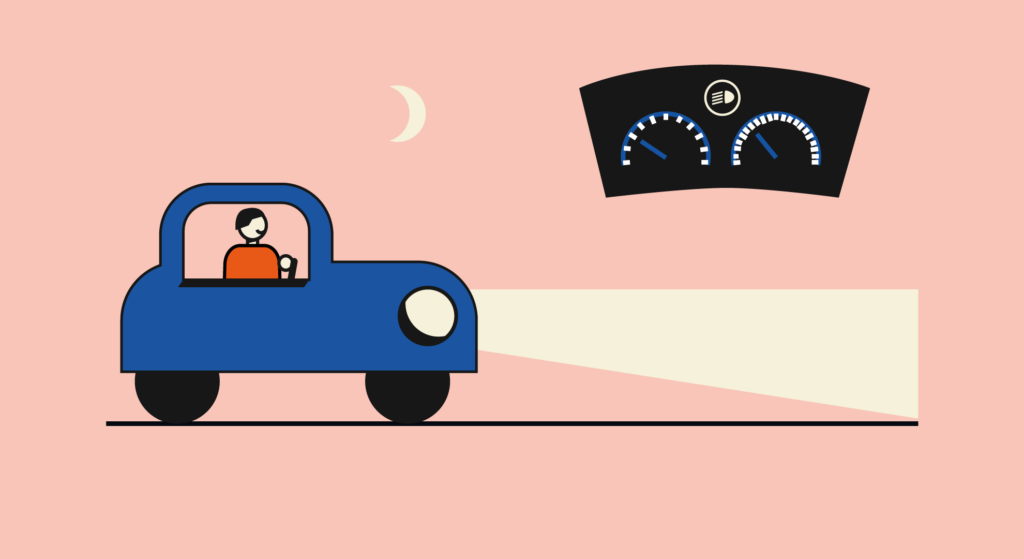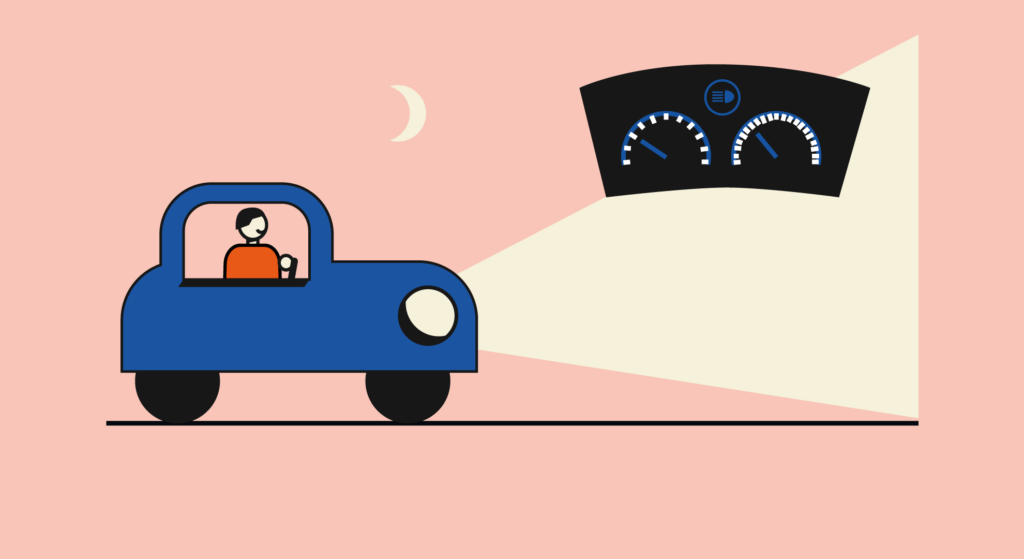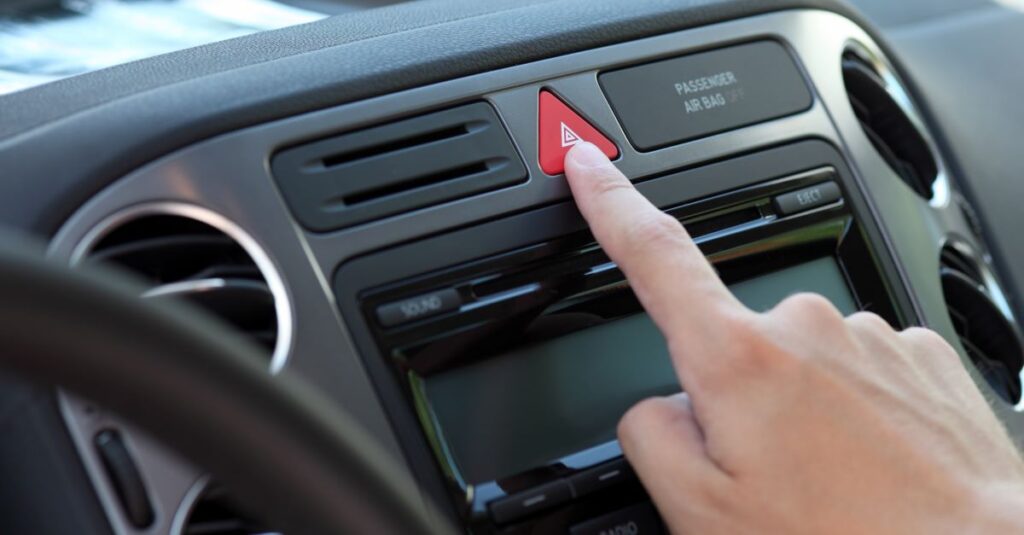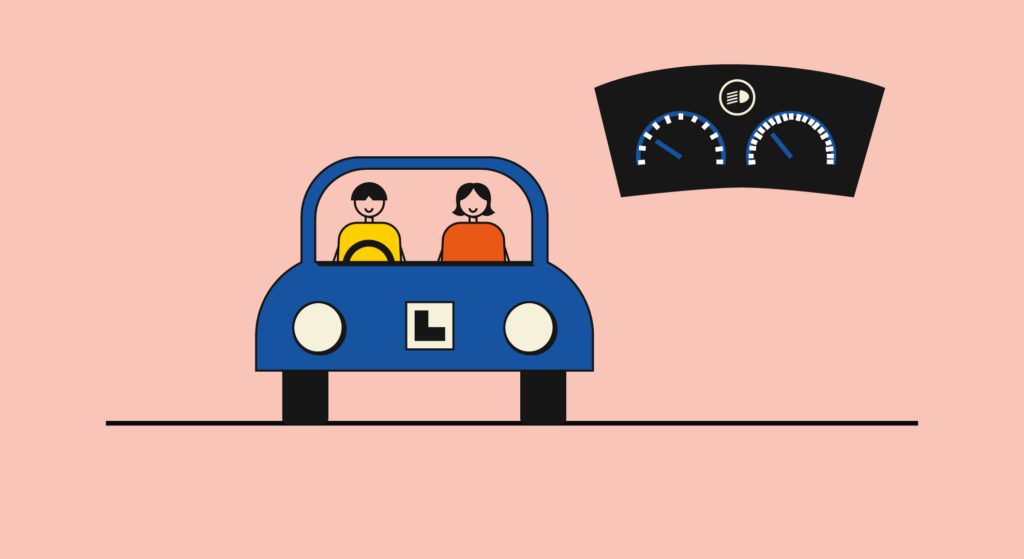Driving at night for the first time can be a daunting experience for learner drivers, but understanding the headlights and other car lights and when to use them is essential if you want to keep confident and safe.
We explore the three main types of car lights – dipped headlights, full beam headlights, and sidelights – to help you navigate the roads after dark, and explain the other lights you need to practise using to drive safely in all weathers and on all occasions.
Dipped headlights

Dipped headlights are your go-to lights for most nighttime driving scenarios. They illuminate the road ahead without dazzling oncoming drivers.
When driving in built-up areas, on well-lit streets, or in the presence of other road users – such as cyclists and pedestrians – dipped headlights are the preferred choice.
Remember to always use dipped headlights when following another vehicle in poor visibility. This helps prevent the glare from affecting the driver in front.
When driving in adverse weather conditions like rain, fog, or snow, dipped headlights should also be activated. This increases your visibility to others on the road and ensures you can see potential hazards well in advance.
You will recognise the dipped headlights symbol because it looks like a headlight lens with lines coming from it pointing down to the ground.
The difficulty often comes in remembering when to turn on your lights in the first place. Luckily, many modern cars have lights that turn on automatically when they detect that visibility is becoming restricted.
Full beam headlights

Full beam headlights – otherwise known as main beam headlights – are designed for maximum illumination and are ideal for use in rural or poorly lit areas where there is little to no oncoming traffic. Drivers should use full beam headlights when navigating unlit country roads, highways, or winding lanes.
However, it is crucial to switch to dipped headlights when approaching oncoming traffic or when driving behind another vehicle. Failure to do so can dazzle other drivers, causing a hazard.
Most modern cars are equipped with an indicator on the dashboard that lights up when the full beams are engaged, providing a visual cue for the driver.
Remember to dip your headlights well in advance to allow your eyes to adjust to the reduced light. This is especially important when transitioning from well-lit areas to darker stretches of road.
The full beam headlight symbol is similar to the dipped beam symbol but the lines coming from it will head straight in front.
Am I allowed to “flash” my full beam headlights to communicate with other drivers?
Flashing your full beam is a matter of much confusion. It is not against the law to flash other motorists but you must flash with caution.
According to the Highway Code, you should only flash your headlights to warn other drivers, pedestrians and cyclists of your presence on the road. This is the only scenario where you are legally permitted to flash your headlights.
So you could be courting disaster, and potentially breaking the law, if you flash someone to thank them for giving way to you, warn them of a speed camera because they have driven badly, or because you recognise them.
Sidelights
Sidelights, sometimes known as parking lights, serve a different purpose than dipped or full beam headlights. They are not meant for driving but are useful in specific situations. Learner drivers should use sidelights when parked on the side of the road in low light conditions, such as during dusk or dawn.
Sidelights provide minimal illumination and are not a substitute for proper driving lights. Using sidelights when driving can compromise your visibility and safety, so it’s essential to switch to dipped or full beam headlights when you resume driving.
Fog lights
Fog lights shine through fog and mist, which differs from full beam lights that are reflected by fog. You have front and rear fog lamps, with the switches coloured coded: amber for the rear and green for the front.
According to the Highway Code, you should only use your fog lamps when visibility is seriously reduced and below 100 metres (328 feet). You shouldn’t use your fog lights when visibility is better than that, as you may dazzle other drivers.
Indicators
The indicator lights are positioned on each corner of your vehicle. The blinking amber lights are turned on and off down one side of your car using your indicator stalk on the steering wheel. They also automatically turn off once you straighten your wheels after making a turn.
You should use indicators to show other road users and pedestrians where you intend to turn. This includes on roundabouts or when pulling away, overtaking and changing lanes.
Hazard warning lights

Your indicators double as hazard warning lights and are turned on with a switch bearing the symbol of a warning triangle. Whereas the indicators only light one side at a time, your hazard warning switch will turn on all four indicators and they will flash simultaneously. The blinking amber lights warn other drivers of danger or obstructions on the road.
You should only use your hazard lights if your vehicle is stationary, to warn others that you’re causing a temporary obstruction, or on a motorway when you are warning other drivers there is an obstruction ahead of you.
How to use your car lights and headlights responsibly
1. Familiarise yourself with your vehicle
If you’re unfamiliar with your car lights, take advantage of quieter roads or empty parking lots to practise switching between different light settings. Familiarity with your vehicle’s controls is key to confidently driving at night.
2. Be conscious of your surroundings
Be aware of your surroundings and adjust your lights accordingly. In urban areas or when following other vehicles, stick to dipped headlights. On open roads with no oncoming traffic, full beam headlights are your best bet.
3. Keep your car maintained
Regularly check and maintain your vehicle’s lights to ensure they are in working order. Replace any bulbs that are dim or burnt out promptly.
Make sure you have the right insurance in place
Adrian Flux offers flexible learner driver insurance which can be purchased annually, monthly or daily, depending on your needs. Prices start from 65p a day.

